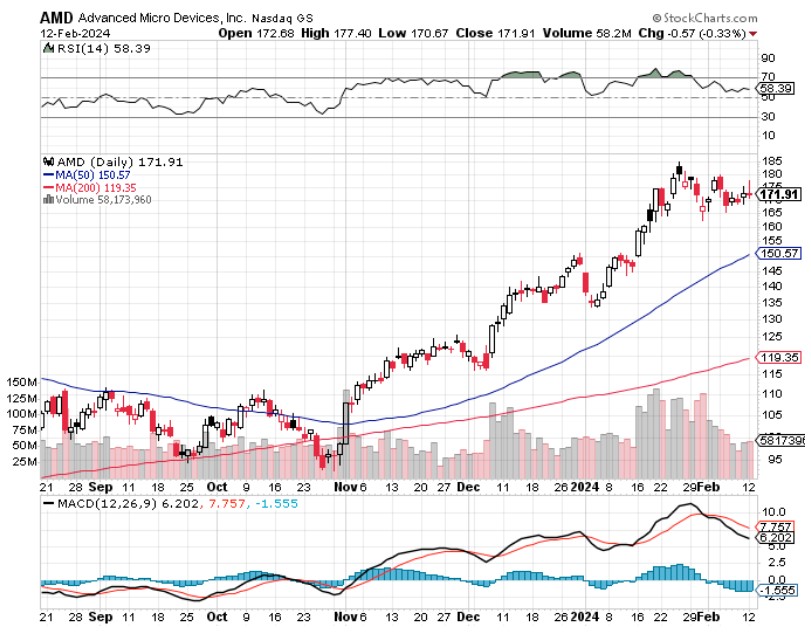(AMD), (NVDA), (INTC), (MSFT), (AMZN), (TSLA), (PLTR), (WBM)
Imagine cruising down the digital highway, where AI is fueling everything from your playlist recommendations to your investment decisions. At this point, we're no longer just talking about the future; we're living it.
So, who's driving this transformation? There’s no clear winner just yet, but Advanced Micro Devices (AMD) is making a compelling case as the potential leader of the AI revolution.
The AI market is growing impressively fast, with this segment expected to hit nearly $2 trillion by 2030. That's a lot of zeroes, my friends.
And smack dab in the middle of this gold rush is AMD, offering the shovels, pickaxes, and denim jeans to every AI prospector out there. Whether you're mining for AI gold in supply chains or marketing, chances are this company’s tech is the backbone of your operation.
Looking into AMD's financials, the company has soared from $6.7 billion in FY 2019 to a jaw-dropping $22.7 billion by FY 2023.
And just when you thought they couldn't go any higher, Q4 2023 earnings came in at a cool $6.20 billion, leaving Wall Street's estimates eating dust.
With earnings per share hitting $0.77, we're not just whistling Dixie — AMD is on fire.
But here's where it gets more interesting. AMD is eyeballing a slice of the AI chip market pie, projected to be worth a whopping $400 billion by 2027. And with Nvidia (NVDA) in the race, it's shaping up to be the tech equivalent of Godzilla vs. King Kong, minus the city destruction.
For context, AMD’s market cap is at around $277.77 billion while Nvidia’s is at $1.78 trillion. Despite this massive gap, AMD is not just holding its own; it's thriving, thanks to its Swiss Army knife approach to AI hardware.
Apart from these two, another player in the sector is Intel (INTC), which stands closer in size to AMD at $186.16 billion in market cap.
Unfortunately, Intel has been lagging behind like a kid trying to catch the ice cream truck on a tricycle. Their recent foray into AI chips feels a bit like showing up to the party after the cake's been eaten.
AMD, on the other hand, has been playing 4D chess with its AI investments, offering a smorgasbord of AI-optimized goodies for every conceivable need.
They rolled out the world’s first data center APU — a CPU and GPU living together in harmony on one chip. Price-wise, it’s a steal, and it's got Intel looking at their balance sheets a little worried, especially after their data center bucks took a 30% nosedive.
More importantly, this advancement would make AMD a go-to choice for big names in tech like Tesla (TSLA), Palantir (PLTR), Amazon (AMZN) and Microsoft (MSFT), retail giants such as Walmart (WMT), and even government agencies like NASA.
And for us regular folks? AMD's dishing out PC CPUs that are all about that AI life, like the Ryzen 8040. Plus, they've got these server CPUs for the big enterprise crowd.
In fact, AMD has flooded the market with millions of these Ryzen AI-powered PCs, and now they're in more than 90% of AI-enabled PCs out there. They were the first to toss a dedicated AI module into desktop processors, leaving the competition eating their dust.
Speaking of the competition, Intel’s just now getting their feet wet with AI-powered CPUs and hasn't seen the cash flow they hoped for in a while. Nvidia? They're the new kid on the CPU block. So, in the grand scheme of things, AMD's looking like the cool, experienced senior among freshmen.
Now, why should you care? Well, if you're looking to invest in a company that's got its fingers in the AI pie, AMD is your Huckleberry.
With a market cap that's a fraction of Nvidia's, AMD offers a value proposition that's as enticing as a slice of pie on a Sunday afternoon. I suggest you buy the dip.


